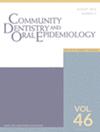How well do parents identify their child's baby teeth? Engagement and accuracy of parent-reported information on a tooth checklist survey
Abstract
Objectives
Naturally exfoliated primary teeth are being increasingly collected in child development studies. Most of these odontological collections and tooth biobanks use parent-reported information from questionnaires or tooth checklists to collect data on offspring teeth. To the best of the authors' knowledge, no studies have assessed parental engagement in tooth checklists, nor parental accuracy in identifying their child's baby tooth. This study aimed to evaluate these dimensions by analysing data from the about this tooth checklist returned with donated primary teeth in a natural experimental study called STRONG (the Stories Teeth Record of Newborn Growth).
Methods
Parental self-reported information were analysed on checklists returned with 825 primary teeth belonging to 199 children. The percentage of blank answers was calculated for each question. The accuracy of parents-reported tooth identification was evaluated by comparing parental ratings to researchers' ratings. Reliability of researchers' tooth identification was first evaluated by calculating intra-observer and inter-observer agreements, as well as Cohen's Kappa values. The percentage of accuracy of parents' tooth identification (relative to researcher's) was then calculated, and logistic regressions were used to evaluate if time elapsed between when exfoliation occurred and the checklist was completed associated with parental accuracy in tooth identification.
Results
Parents returned 98.4% of the checklists and completed 74.9% to 97.7% of the questions. Excellent reliability was demonstrated for researchers' intra- and inter-rater tooth identification (agreement percentages >90%; Cohen's Kappa values >.83). Moderate accuracy of parents-reported tooth identifications was found, with parents correctly identifying 49.5% of the donated tooth. Better parental accuracies were highlighted for partial identifications (87.1% of correct jaw, 75.6% of correct tooth type, and 65.8% of correct lateralization). Logistic regressions showed the odds of correct parental identifications decreased on average by 1.8% every 30 days of distance between tooth exfoliation and checklist completion.
Conclusions
While parental engagement is high, parents-reported tooth identifications have moderate accuracy, which decreases over time. High accuracy is however found for partial identifications. Parent-reported information on the accompanying questionnaire of naturally exfoliated primary teeth collection or tooth biobanks, even when filled in a long time after exfoliation took place, should be encouraged. However, expert identifications of teeth should remain best practice.

 求助内容:
求助内容: 应助结果提醒方式:
应助结果提醒方式:


